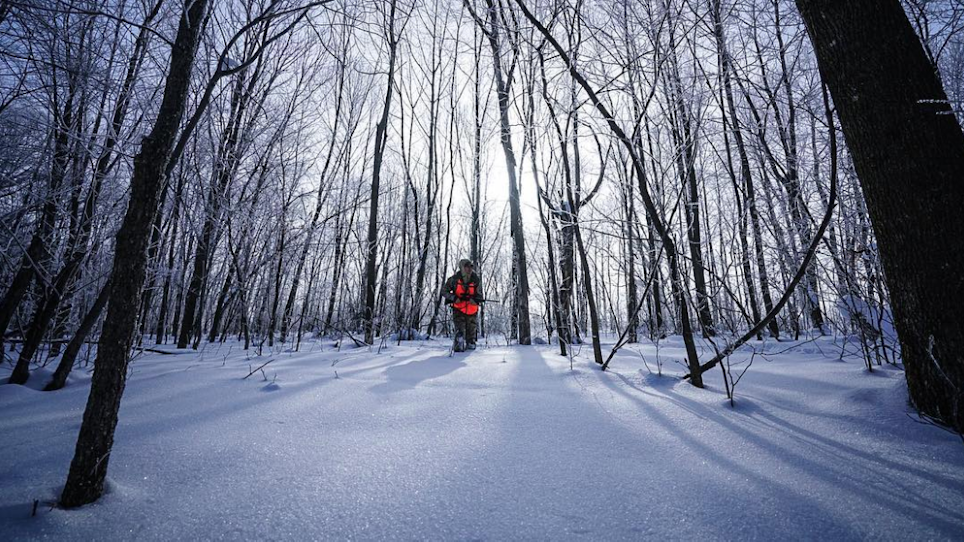
Photo: @mitchellpantzke (Pnuma/Instagram)
Cold temperatures — particularly temps from -30 to 30 degrees Fahrenheit — begin to wreak havoc on the body and its ability to perform. This should be of concern to the hunter who is often required to weather the cold while sitting still, unlike other outdoor enthusiasts such as backpackers, rock climbers or cross-country skiers who are moving and exerting themselves.
Failure to insulate the body and select the right performance apparel can unintentionally wipe away the work hunters do to prepare for hunting season. Work like all of those practice shots logged at daylight and twilight. Not to mention pre-season scouting. Even the small things like the care given to quietly walk into a hunt site and the same carefulness walking out. All of this can be nullified by a low body temperature.
And all too often, the hunter blames himself rather than the cold. Maybe he drew his bow too early and failed to steady it when his shot opportunity arrived, or he wasn’t as fluid in his movements and he screwed up his chance at a buck he’d watched on the trail cams all season. Maybe he hurried the shot, failed to be patient or disciplined enough.
But what if these failings could be attributed to the body’s response to cold weather?
What You Should Know
82 is a magic number for muscle endurance.
When muscle temperature falls below 82°F, muscular endurance decreases. Whether an outside temperature can drive muscle temps down below that 82-degree marker varies based on clothing or the body’s insolation.
What 30 minutes at 10 degrees can do to an uninsulated human body.
In 2015, ESPN’s popular “Sport Science” series used an ice truck to simulate the freezing environment at the NFL’s storied Lambeau Field in Green Bay, Wisconsin. They set the temperature at 10 degrees Fahrenheit, and the show’s host, who had taken baseline temperatures beforehand, entered the truck for 30 minutes.
Here's what happened:
Grip Strength: In a cold environment, the body’s most important job is to maintain core temperature. The show host started with a core body temperature of 99 degrees. To maintain this, the cardio vascular system pumps less blood to our extremities. In just 15 minutes, the skin temperature of the man’s hands plummeted to 35 degrees. Consequently, when his grip strength was tested, it was cut in half compared to the strength he demonstrated prior to entering the truck. Now considered that as it relates to key movements required to make an accurate bow shot: grip, draw, release. The negative impact could hinder accuracy or, maybe you don’t get a shot off at all. A quick decline in grip strength from the cold causes limbs and movement to become clumsy. A jerky movement lacking stealth and fluidity will often give you away before your bow is even drawn.
Rapidly Burning Glucose: After 30 minutes of exposure, the host’s core body temperature was remarkably stable at 99 degrees. But, for the body to keep the core protected and functioning, it robs from its stored glucose and uses that energy at a rate of five times what’s used in warm weather.
Reaction Times: The rapid burning of glucose leaves less energy for performance and, as a result, the “Sport Science” show host experienced reaction times that were reduced by 45 percent. Inversely, any chance a big buck’s reaction time declines by 45 percent as well? No way. As a hunter’s ability to move and react decreases in cold weather, it has the opposite affect on big game. The cooler weather, the more active big game will be.
When limb movement becomes clumsy.
Motor performance declines and with every 1.8° Fahrenheit drop in muscle temperature below its normal level. Meanwhile, the normal skin temperature averaged throughout the whole body is 91.4° Fahrenheit. But when this value drops below 77° Fahrenheit, extreme discomfort is felt. Still, values of 73.4° Fahrenheit can be dealt with, but that’s when limb movement becomes clumsy, the joints stiffen due to the synovial fluid becoming more vicious as the temperature drops.
Source: DNA Sports Performance (2013)
When cardiorespiratory endurance decreases.
There are three factors that contribute to a decrease in endurance due to cold weather, but the primary cause is due to a decline in maximum heart rate when the body is cooling which hampers a person’s ability to sustain strenuous exercise. The rate of declining endurance depends on environment and an individual’s fitness level. Source: Human Kinetic
For sportsmen and outdoor athletes, performance apparel isn’t only about staying warm and comfortable in colder climates. Freezing temperatures and other weather events can directly impact the success. Next week’s email explores how to minimize the weather’s impact on your body and, ultimately, your hunt.






